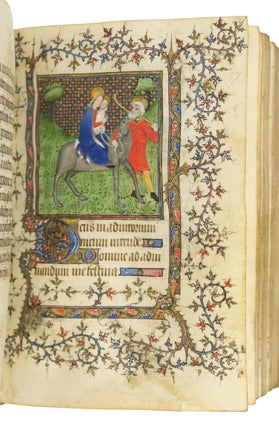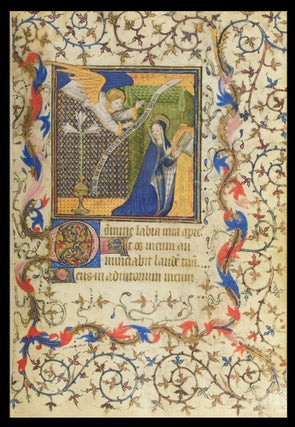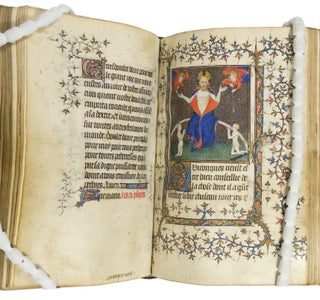Evidence Of A Special Early Moment In Parisian Book Production Expressive Of Northern Realism
Book of Hours.
Paris, 1400.
Use of Paris) In French and Latin, illuminated manuscript, on parchment France, Paris, c. 1400-1410 15 large miniatures by the Master of the Bible Historiale MS fr. 159 (as described by Les Enluminures)
This beautifully executed and unusual Parisian Book of Hours was painted at the time of the Duke of Berry. The “realism” seen in the illuminations represents a special moment in Parisian art, one exemplifying its northern origins. The miniatures are attributed to one of the artists responsible for the Bible Historiale also referred to as the Master of the Bible Historiale fr. 159 (Paris, BnF MS fr. 159). The female patron who ordered the book appears twice in the miniatures.
224 folios, mostly in gatherings of 8 (i12), complete, pastedowns and two flyleaves at front and back, some catchwords, written in a dark brown ink in a gothic liturgical script, on 14 long lines, by different hands, ff. 82-82v and ff. 219v-223v written by a slightly posterior hand, ruled in light red ink (justification, 62 x 85 mm), rubrics in red both in French and Latin, versals in burnished gold on alternating pink and blue grounds with pink or blue infill and white tracery, line endings pink and blue with burnished goldleaf discs and white tracery infill, 2-line initials in pink or blue with white tracery on burnished gold grounds with ivyleaves extending in the margins and infill, one 3-line initial at the beginning of the Hours of the Virgin, pink with white tracery, burnished gold and ivyleaf infill on a blue ground 3-line initials marking the start of the main texts, pink or blue with white tracery on highly burnished gold grounds with ivyleaf infill, one 4-line letter I, traced in pink and white with ivyleaf infill on a burnished gold ground richly decorated borders with extending baguettes (foliate pattern on burnished gold grounds) and dense ivyleaves in borders, 15 LARGE MINIATURES, at the beginning of the main texts, in excellent condition. Nineteenth-century dark brown morocco binding over pasteboards, frame of two gilt fillets on covers, smooth spine, cropped edges affecting very slightly the border decoration at the top edge, never affecting text or illuminations, in clamshell box. Dimensions 161 x 116 mm.
PROVENANCE: 1. Liturgical use and calendar secure a place of origin in Paris. Probably made for the woman patron who appears kneeling on fol.110 and 185. 2. Isydort Bernardon and Marthe Galberict, first front fly-leaf. Second front flyleaf reads as follows: “Isydort Bernardon Bon Compaion qui esme Monsieur...”(Last word is difficult to read); XVIIth century. 3. Du Buisson and Marchand families, eighteenth-century notes on family history and marks of ownership (1716 and 1717), back pastedown and fly-leaves: “Ces presentes heures sont tenues de defunst Charles du Buisont (...) Seigneur de Lublataris demerant a St Michel...” ; “Ces presentes heures appartiennent a moy Gabriel Marchand. Je prie ceux et celle quy les trouveront de me les rendre. Je les reconpanseré (sic) de leurs payne fait a St Michel le traize jour de fevrier 1716", signed Marchand; “Jeanne du Buisson fille de Charles du Buisson a espouzé Gabriel Marchand, 1717.” The name “Despanage” with the date 1716 also appears on the first flyleaf. 4. Engraved ex-libris pasted on front pastedown, eighteenth-century. “M. Titon de Villotran, conseiller au Parlement”. Jean-Baptiste Titon de Villotran is recorded as a “conseiller” in the Parlement de Paris (see Chesnaye-Desbois and Badier, Dictionnaire de la noblesse, vol. 19, Paris, 1876). 5. Les Enluminures/ Bruce Ferrini, Catalogue 9, Books of Hours, 2000, no. 1, hence Private Collection.
TEXT: ff. 1-12, Calendar, red, blue and burnished gold, in French, with numerous Paris saints such as Genevieve (in gold), Germain, Landri, Marcel, Cloud; ff. 13-18, Gospel Sequences; ff. 18-18v, Various Prayers : “Protector in te”; “Ecclesiam tuam quesimus”; “Omnipotens sempiterne...”; ff.19-22, Obsecro te; ff. 22v-26, O intemerata; ff. 26v-27, Prayer, “Deus qui noluisti pro redempcione...”; ff. 27-27v, Prayer, “Commendo tibi Sancta Maria...”; ff.. 27v-28, Prayer, “Signum crucis dominum...”; f. 28v, blank; ff. 29-80v, Hours of the Virgin, use of Paris Matins (f. 29), Lauds (f. 39v), Prime (f. 50) with ant. “Benedicta tu” and cap. “Felix namque”, Terce (rubric erroneous) (f. 55bis); Sext (f. 59v); None (f. 63v) with ant. “Sicut lilium” and cap. “Per te Dei”; Vespers (f. 68); Compline (f. 75); ff. 80v-81v, Suffrage to Sebastian (written in a different but contemporary hand) “Anthienne de saint Sebastien” et “Oroison de saint Sebastien”; ff. 82-82v, Salve regina (different hand, slightly posterior); ff. 83-83v, blank except for a XVIIth century inscription on fol. 83, in brown ink that reads : “Bernardon, 1648”; ff. 84-102, Penitential Psalms and litanies; ff. 102v-105v, Short Hours of the Cross; ff. 106-109v, Short Hours of the Holy Spirit; ff. 110-115v, Fifteen Joys of the Virgin (in French); ff. 116-119v, Seven Requests to Our Lord (in French); ff. 120-184v, Office of the Dead, use of Paris; ff. 185-204, Suffrages; ff. 204-218, Prayers: “La priere Theophilus”: “Glorieuse vierge royne...” (ff. 204-213v) ; “Tres devote oroison de la sainte trinité”(ff. 213v-217); “Omnipotens sempiterne deus qui dedisti nobis...” (ff. 217-218); ff. 218-218v, Seven verses of St. Bernard; f. 219, Prayer: “Omnipotens sempiterne Deus qui Ezechie...”; ff. 219v-221v, Prayer for Communion, “Tres devote oroyson quant on veult recevoir le corps de nostre seigneur...” (Different hand); ff. 221v-224v, Prayer upon receiving Communion, “Tres devote oroison quant on a receu le corps de nostre seigneur”.
ILLUSTRATION: f. 29, Annunciation; f. 39v, Visitation; f. 50, Nativity; f. 55bis, Annunciation to the Shepherds; f. 59v, Adoration of the Magi; f. 63v, Presentation in the Temple; f. 68, Flight into Egypt; f. 75, Dormition of the Virgin; f. 84, God in Judgment; f. 102v, Crucifixion; f. 106, Pentecost; f. 110, Female donor presented by patron saint John the Baptist, kneeling before the Virgin and Child; f. 116, Last Judgment; f. 120, Funeral Mass; f. 185, Donor kneeling before her patron saint John the Baptist. An unrecorded Parisian Book of Hours, this manuscript has a sequence of beautifully executed miniatures attributed by François Avril to one of the artists responsible for the Bible Historiale (Paris, BnF MS fr. 159), a grand manuscript given to Jean Duke of Berry by Raoulet d’Auquetonville before 1402. Our Book of Hours was painted for an unidentified female donor depicted twice in the manuscript. Once she kneels in prayer before St. John the Baptist, who must be her patron saint (f. 185). A second time St. John the Baptist presents her to the Virgin and Child whom she adores in prayer (f. 110). Her costume befits a lady of the court and suggests a date around 1400. The paintings corroborate this date. The Bible Historiale is regarded as one of the earliest works of an artist, surely trained in the Netherlands, who appeared in Paris at the beginning of the fifteenth century and cannot be traced after 1405. Bella Martens called him the “Master of 1402,” and Millard Meiss in 1967 renamed him the Master of the Coronation of the Virgin after a stunning frontispiece of this subject in a manuscript of Jacobus de Voragine’s Golden Legend of 1402-03 (Paris, BnF MS fr. 242). In Paris, working with collaborators on large projects, the Coronation Master was responsible for a sequence of richly illuminated volumes that include the Fleur des histories de la terre d’Orient (Paris, BnF MS fr. 12201) and Boccaccio’s Des cleres et nobles femmes (Paris, BnF, MS fr. 12420). Among the related hands in the lavish Bible Historiale, emerges as a distinctive personality, who must have had his own workshop. Working side by side with the Coronation Master, the Master of the Bible Historiale assimilated his style, and our manuscript recalls some of these early works. We suspect that our artist, like the Coronation Master, originated in the North, because of the “realism” of the exceptionally fine miniature of the Nativity (f. 50) with its hemp floor and wattled fence, the tenderness of Joseph seated close to the Virgin Mary, and the bare breasts of the reclining Virgin. The finely tessellated diaper backgrounds and the triangular tiled floor that tilts upward, both repeatedly used in our Book of Hours, also occur in the miniature of the Coronation of the Virgin. In the Funeral Mass (f. 120) the dark outlines for the expressive faces are comparable to those in Clerics Singing in the Bible Historiale. Likewise, the soft features of the Virgin’s rounded face, the crisp modeling in her garment, and her slender delicate hands are found in the Coronation of the Virgin and elsewhere. Sprinkled with tiny plants the blossom with red, blue, or white flowers, the simple landscapes reappear in the Bible Historiale. The rendering of the donors anticipates the treatment of the female heroines in the Boccaccio manuscript. The engaging style of the Master of the Bible Historiale, like that of Jacquemart de Hesdin and the Master of the Breviary of Jean sans Peur, exemplifying a “realism” that derives from their northern origins, represents a special moment in Parisian illumination, one that was short-lived. Art in Paris was to evolve in another direction which the more refined, cosmopolitan style of the Boucicaut and Bedford Masters best represent.
(THIS FULL DESCRIPTION TAKEN FROM THE CATALOG OF THE FIRM LES ENLUMINURES)
Meiss, Millard 300, 312, 355, II, fig. 822; French Painting in the Timede Berry974, I, 383-4, II, figs. 458-64
HBS 66569
$350,000.
Price: $350,000.00
Item #66569





